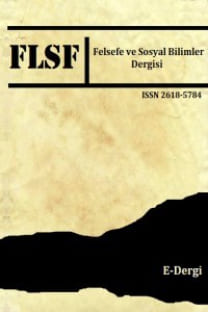Zamanın Anlık Bilinci: Husserl ve Broad Modelleri Bağlamında Dainton’un Aldatıcı Şimdiki An Modelini Yeniden Düşünmek
Instantaneous Consciousness of Time: Reconsidering Dainton’s Model of the Specious Present in the Context of Husserl’s and Broad’s Models
phenomenology, time consciousness, specious present, instantaneous variation, Barry Dainton, Edmund Husserl C. D. Broad,
___
Dainton, Barry. Stream of Consciousness: Unity and Continuity in Conscious Experience. London / New York: Routledge, 2000.Dainton, Barry. Time and Space. 2nd ed. Durham: Acumen, 2010.
Dainton, Barry. “Time in Experience: Reply to Gallagher.” Psyche 9, no. 10 (2003).
Husserl, Edmund. On the Phenomenology of the Consciousness of Internal Time (1893–1917). Edited by Rudolf Bernet. Translated by John Brough. Vol. 4. Collected Works. Dordrecht: Kluwer, 1991.
Jerison, David. “Limits, Continuity, and Trigonometric Limits (Single Variable Calculus, Session 2).” Class Lecture, MIT, 2007. https://ocw.mit.edu/courses/mathematics/18-01-single-variable-calculus-fall-2006/video-lectures/lecture-2-limits/.
Luck, Steven, and Andrew Hollingworth. “Visual Memory Systems.” In Visual Memory, edited by Steven Luck and Andrew Hollingworth, 3–8. Oxford: Oxford University, 2008.
Miller, Izchak. Husserl, Perception, and Temporal Awareness. Cambridge, Mass.: MIT, 1984.
Priest, Graham. In Contradiction: A Study of the Transconsistent. 2nd ed. Oxford: Oxford University, 2006.
- Yayın Aralığı: Yılda 2 Sayı
- Başlangıç: 2006
- Yayıncı: Hamdi BRAVO
Louis Althusser'de Makine ve Aygıt Ayrımı Bağlamında Devlet Nosyonu
İBN MEYMUN'DA NEDENSELLİK SORUNU
KARL MARX'IN SINIF MÜCADELESİ VE POLİTİK EKONOMİ ANLAYIŞININ ARISTOTELESÇİ TEMELLERİ
Bruno ve Kant: Av ve Avcının İç İçe Geçişi
DAVID HUME'DA AHLAK-SİYASET İLİŞKİSİ: DUYGU TEMELLİ AHLAKTAN FAYDA TEMELLİ SİYASETE GEÇİŞ
KARL MARX'IN SINIF MÜCADELESİ VE POLİTİK EKONOMİ ANLAYIŞININ ARISTOTELESÇİ TEMELLERİ
Rousseaucu Logosantrizm ve Lakonofili: Sparta Bir Mitik Ütopya Mıdır Politik Ütopya Mı?
HUGO GROTIUS'UN DOĞAL HUKUK DÜŞÜNCESİNE KAZANDIRDIĞI PARADİGMAL DÖNÜŞÜM
